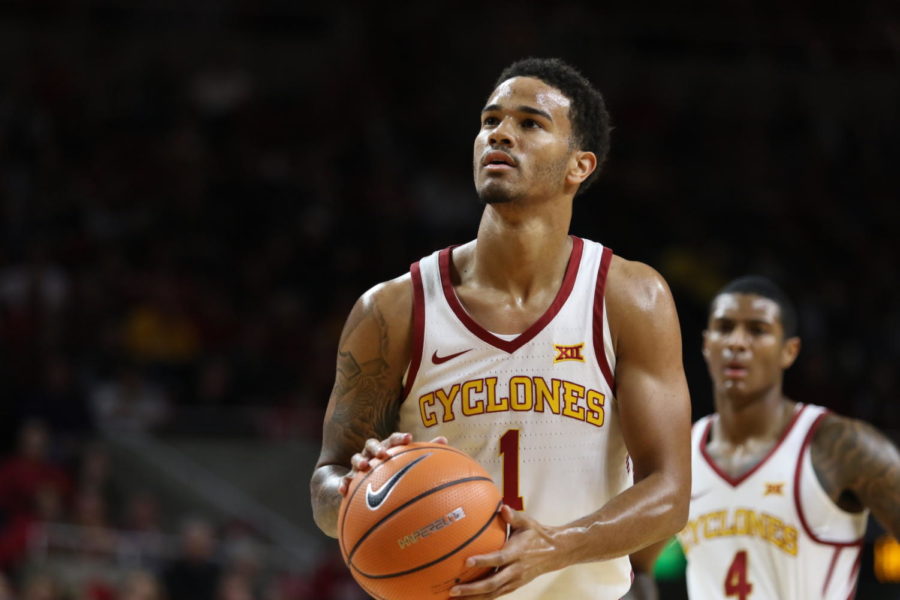It’s about the routine, consistency in free throw shooting for Iowa State
February 19, 2018
The whistle blows and the game comes to a halt as the referee runs over to the scorer’s table to show the type of foul and who the foul is on.
After the referee comes back, the game becomes frozen in time as everyone’s eyes go onto the player taking the free throw.
It can be an intimidating place to stand, especially if it’s the last few seconds of the game and your team needs these free throws to create a lead or win the game.
For home teams, your fans are giving spirit fingers and staying quiet. For away teams, the fans are shouting on the top of their lungs and try to distract the opposing player on the line.
With all of this going around while the player in standing on the free-throw line, the player sticks to his routine.
The majority of players in the NCAA have a simple routine they follow when they put their feet on the free-throw line. Depending on the success, a player might switch up the routine. In the end though, the free-throw line can be a hard place to stand.
“Free throws are probably one of the most difficult shots to me,” said senior guard Donovan Jackson. “Because your concentration level has to be very high.”
Jackson has the highest free-throw percentage on the Iowa State basketball team and, for him, it’s all about practice and repetition at practices and in his free time. The senior guard is shooting 90.6 percent this season from the charity stripe.
Even though he might be having a good season at the free-throw line, the Cyclones as a team aren’t. Iowa State is shooting a combined 71.5 percent from the line, which puts the Cyclones at 156th in the country out 351 teams.
After Jackson, the next highest free throw shooter is senior forward Hans Brase, who’s been out the last four games because of a knee injury. He’s shooting 76.5 percent.
Redshirt junior guard Nick Weiler-Babb is after Brase with a 75.9 free throw shooting percentage. To Jackson, it’s just sticking to the routine and continuing to practice that shot every day.
“I try to shoot the same way every time,” Jackson said. “Try to put my fingers in the basket and shoot it light. Practicing makes it much easier.”
Every player has a different combination they go through before taking their free-throw shot. Some take a longer routine, while others try to make it as short as possible.
For Jackson, he takes a deep breath, bounces the ball twice, takes another deep breath and shoots the ball. For freshman guard Lindell Wigginton, he bounces the ball three times, rolls the ball in his left hand and takes his shot.
Zoran Talley Jr. has one of the longer routines for free throws as he bounces the ball four times, takes a deep breath and releases his shot. Jakolby Long has a quick approach with two quick bounces and then shooting the ball.
For some players, they switch up their routine because of a missed shot or just for no reason. Solomon Young is a prime example of this method. He went 4-for-4 from the free throw line on Feb. 17 at Kansas State, but changed his approach ever so slightly.
The first time up he spun the ball, then bounced the ball and shot. The next time he bounced the ball, then spun the ball and took his shot. Either way, the shot went in with a perfect day from the line for Young.
“I definitely worked on my free-throw form a lot this past summer,” Young said. “I just try to keep my positioning in front of the rim, just keep my arms and feel for the ball. I also use my legs because I know that if I don’t bend my knees and get up I’ll be short. Just staying consistent is key in free-throw shooting.”
It seems like consistency is the key word when it comes to the free-throw line and coach Steve Prohm is trying to find that consistency for the entire team and not just one particular player.
For Prohm, the approach to free-throw shooting is pretty simple. Any time there’s a break in practice, he wants the players to go to the free throw and shoot. It’s the perfect time to do it because the players are tired and that’s when it really counts in the actual game.
“You just hope, as a team, you can be in the 70s,” Prohm said. “You hope everyone can shoot over 70 [percent] and hope your guards can shoot 80, 90 [percent].”
In the end though, it’s between the player, the ball and 15 feet of openness to put the ball in the net. A simple task, but one of the hardest shots in college basketball.







